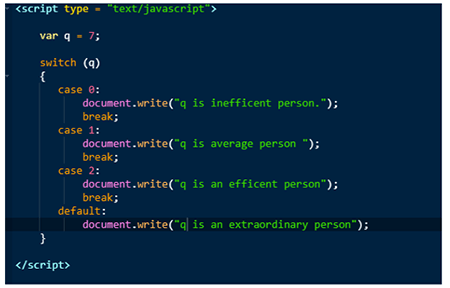

When it encounters the break, it breaks out of the switch. Hence the switch executes the code associated with that case clause. So, whats the point of even having a switch statement, you may ask. It uses search and map techniques to allow variables to change the control flow of a particular block of code or program. A switch statement is essentially the same as a series of if and else-if statements. The default clause of a switch statement will be jumped to if no case matches the expression's value. It is a more efficient and self-explanatory selection control mechanism than multiple if statements. The switch statement evaluates an expression, matching the expression's value against a series of case clauses, and executes statements after the first case clause with a matching value, until a break statement is encountered. In the following example, the expression operation matches the case clause -. In JavaScript, we can use a switch case to branch out in multiple directions based on different conditions. The break keyword tells the interpreter that the code inside any. If you noticed in the above syntax, every case ended with the break keyword. If none of the case values matches with the expression result, then it will start to execute the statements starting from the code associated with the default clause.īy convention, the default clause is the last clause, but it does not need to be so. The switch case statement takes an expression inside the parenthesis and then it checks that expression for different cases and executes the particular code or the statements associated with that case.

Only the first match is considered, even if there is more than one match. It continues to execute the statements until it reaches When it finds a match, the switch statement then executes the statements starting from the code associated with the case clause that matches. As we said before, the Switch statement in JavaScript may have n number of cases. It then starts to compare the result of the expression with each case value. The working functionality of this is almost the same as if condition.

Within the individual case clause, we may write several statements How it worksįirst, the switch expression evaluates its expression. The switch case statement is a multiway branch statement. The default clause must not have a value. We follow switch expression with curly braces with one or more case clauses and an optional default clause.Įach case clause must have a value terminated by a colon. The JavaScript evaluates the expression (switch expression) and compares it with values in the case clause. In this case, that means you are comparing age to either true or false (the result of the expression (age >= 0 & age ) => max >= age)?.The switch statement starts with keyword switch and expression in parentheses. Within a switch statement are multiple >cases, each case contains a return or break keyword and the optional default case. Each case branch of a switch statement expects an expression, and the value of the expression will be compared to the initial argument. A switch works by testing the value of the expression in switch (expression) against the values of each case until it finds one that matches.


 0 kommentar(er)
0 kommentar(er)
